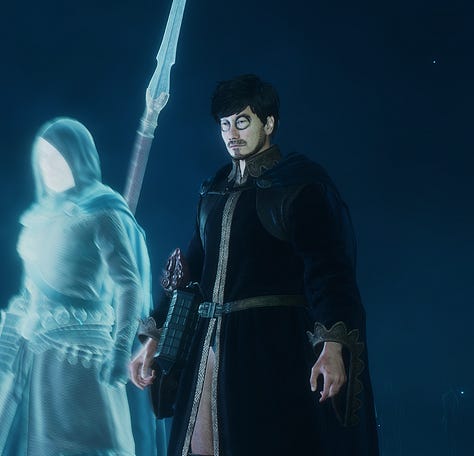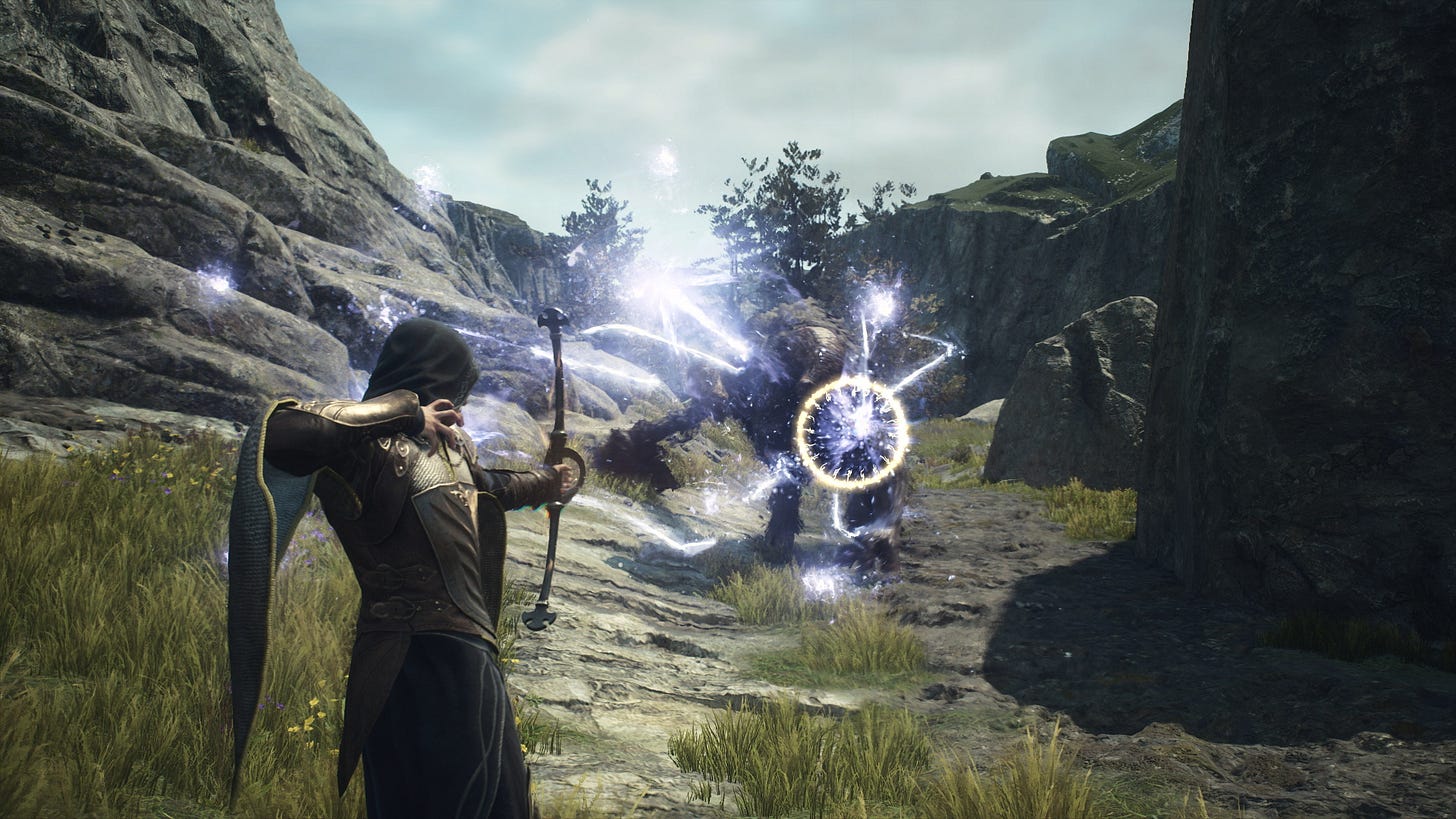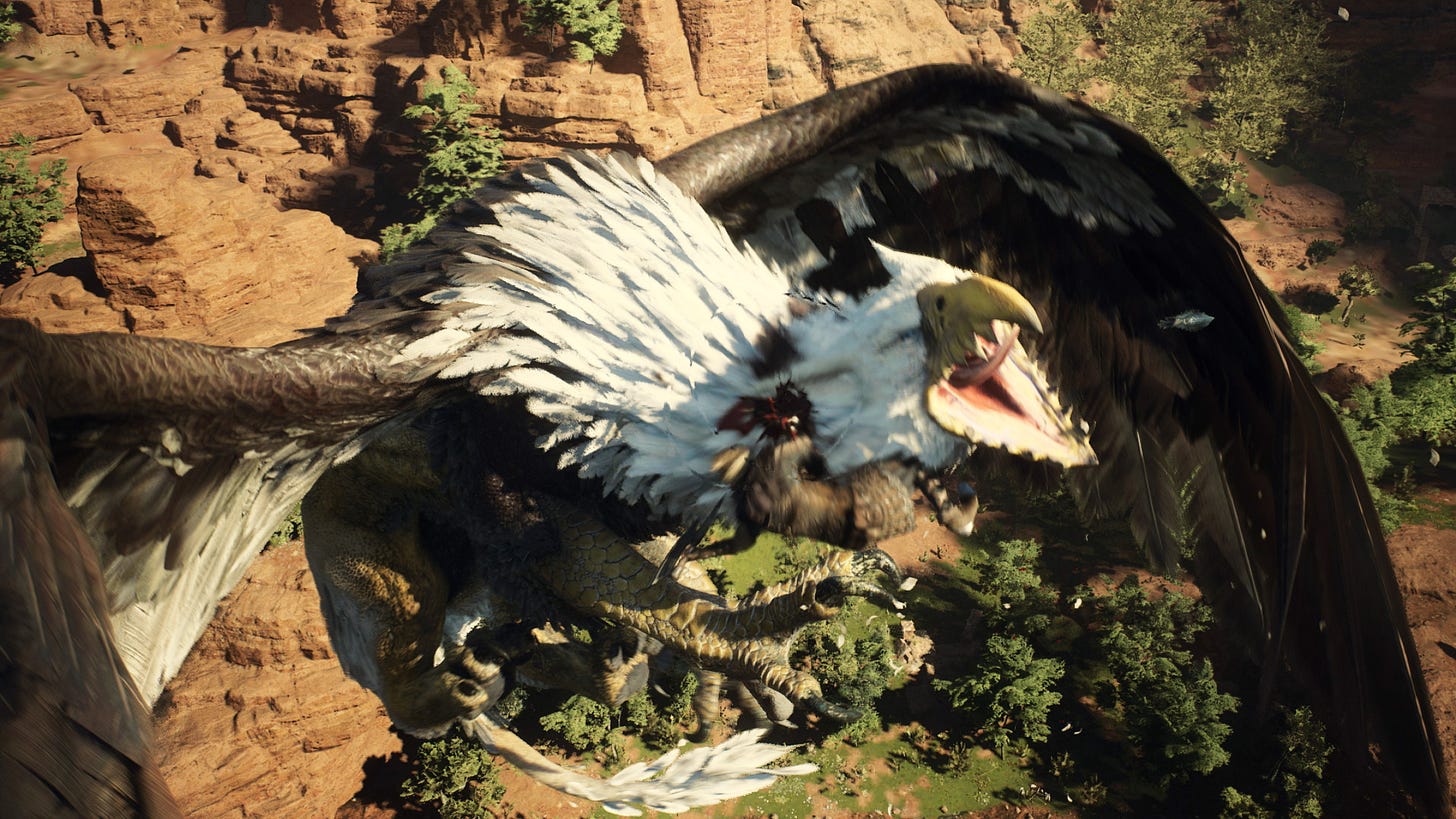Dragon's Dogma 2 Review
For better or for worse, this reimagining of a decade-old action RPG offers plenty of friction.
Written by Tpage (@tpagetenor)
If there’s one common theme among online discussions surrounding Capcom’s Dragon’s Dogma 2, it’s friction. Whether that term is framing the game in a negative or positive light, it’s a recurring feeling that the game pushes back against you at every turn. But in my dozens of hours exploring the lands of Vermund and Battahl, I felt differently. Dragon’s Dogma 2 is defiant. It exists as it is, and doesn’t particularly care for you as the player or the main character. It’s brilliant.
Dragon’s Dogma 2 is almost more of a remaster of 2012’s cult favorite original, in the vein of Bluepoint’s Demon’s Souls remaster for the PlayStation 5. The scope is grander, the setting is different, and the combat is tighter, but the game’s essence remains unchanged, and it largely retells the same story.
As an evangelist for Dragon’s Dogma: Dark Arisen (the definitive edition of the original title with DLC included), I’ve been enthralled. Yet it is undeniable that the past decade of gaming has soured me on certain aspects of Dragon's Dogma 2’s design. Ultimately, while it feels like a wishy-washy verdict, it’s hard to predict whether any person will love or detest this game. I’m going to endeavor to explain why I love it.
Intricate Branches From the Same Tree
Once again, you play as the Arisen – a citizen chosen at random by an apocalypse-heralding dragon to be the hero that can slay said dragon. The Arisen is the only person capable of commanding the Pawn Legion, a group of humans and Beastren that travel across dimensions to assist the Arisen in their quest to defeat the dragon.
In addition to fully customizing your playable character, you will create a “Main” Pawn that will be by your side through the entire journey. You can then fill out your party with up to two additional Pawns made by other players. It’s a fun element of asynchronous multiplayer in a decidedly single-player experience and functions nearly identically to the first game. You and your main Pawn will level up together, while those you hire do not and will eventually need to be swapped out. Dragon’s Dogma 2 boasts a fantastic character creator, and the Pawn pool is already filled with countless celebrity lookalikes and pop culture references. I’ve lost count of how many Timothée Chalamet archers or Kratos warriors I’ve hired across my adventures.



Unlike its predecessor, Dragon’s Dogma 2 offers two expansive countries for players to explore. After a brief tutorial sequence, you’ll begin your journey proper in Vermund, a more traditional western fantasy setting featuring lush forests, rolling hills, and a primarily human population. Later in the game, you’ll venture southwest to the neighboring desert region of Battahl, dominated by the newly introduced Beastren race of cat folk. While both nations are vast and harbor numerous secrets, this is not Skyrim or Breath of the Wild in terms of how you explore. Instead of sheer acreage, Dragon's Dogma 2 opts for countless intersecting and intertwining pathways between major destinations. Caves, mines, and dungeons often have a rear exit that puts you well across the map from their entrances, and slowly uncovering your favorite routes between cities and towns is a joy.
Travel is a significant part of the design and vision for this title, with extremely limited fast traveling options forcing you to hoof it for many, many hours. This choice will likely be one of the most divisive aspects of the game, particularly among newcomers. As your adventure begins, you’ll likely head from Vermund’s capital city to complete a quest, then return for your reward. While there are plenty of places to explore and find, strict inventory weight limits and the threat of nightfall will tend to restrict your time in the wilderness until you become much stronger.
Night in Dragon's Dogma 2 is oppressively dark and brings forth much more challenging monsters that can easily wipe an unprepared party. Eventually, you will begin to amass rare Ferrystones that can instantly whisk you back to any Portcrystal you’ve found, but the established destinations are limited. This is slightly augmented by up to 10 Portcrystals that you can place yourself, allowing you to build your travel network. However, the portable Portcrystals are agonizingly rare, though Capcom will happily sell you one for $2.99 USD.
The greatest advice I can impart to truly enjoy this seemingly archaic and limiting means of navigating the map is to not approach this like a typical open world RPG. Side-quests, in particular, are aggressively mediocre, from the writing to the objectives to even the rewards. They’re not really the point, though. With the exception of time-sensitive quests that will make themselves quite obvious, there’s not much urgency behind anything you’re tasked with doing. Instead of approaching quests as a checklist to be completed, take the time to thoroughly explore the area a quest might send you to. The world is rich with secrets you will miss completely if you aren’t curious.
I adored that Baldur’s Gate 3 didn’t care if you skipped entire questlines, dungeons, or even whole party members. We are in a period of game design where every title is desperate to show you every single piece of content the developers worked so hard on, so it is genuinely refreshing to simply be given a toybox and told to go make your own fun.
Devil May Quest
Combat was the standout feature of the 2012 title, and that remains the same here. Across 10 different classes (called vocations here), players will shoot, stab, sling spells, and mesmerize their foes in a cacophonous display of particle effects and chaos. Disappointingly, the sequel has reduced the number of active skills from six to four, but each skill feels more honed and unique in contrast. There is no lock-on, and for the first several hours, you’ll likely be fighting the camera almost as much as the pack of harpies dive-bombing your party.
Once it clicks and you settle into the rhythm of combat, utilizing proper positioning and maintaining control of the battlefield, the combat system really starts to sing. Clambering up a scraggly cliff face to gain an elevated advantage as an archer or rushing in front of a deadly attack to protect your caster as a warrior feels fantastic when you pull it off. Other times, you might blindly stumble into a pack of heavily-armored Hobgoblins and get stun-locked to death in seconds. It’s a dangerous world that rewards observation and planning while punishing recklessness.
Starting out, you will only have access to four basic vocations: your standard sword and board fighter, the dual dagger-wielding thief, an archer, and a mage. Eventually, you will unlock two advanced vocations in the brutish warrior, who trades the fighter’s defensive capabilities for massive two-handed weaponry, and the sorcerer, who forgoes the mage’s support spells for massively increased destruction.
Finally, out in the world, players will find four additional vocations that can only be used by the Arisen. Three of these are brand new to the series, with the fan-favorite Magick Archer filling the fourth slot. The Trickster class deals no direct damage, instead conjuring specters to confuse, control, and defeat your foes. The Mystic Spearhand combines a double-bladed spear with magic to allow you to live out your medieval Darth Maul fantasy. And finally, the Warfarer is a jack-of-all-trades type that lets players mix and match weapons and abilities from any other vocation. Unlike the first title, each class feels extremely distinct, though some, like the Trickster, have a much steeper learning curve to truly master.
Your companion Pawns act independently based on their personalities and learned experiences from traveling with other players. However, you do have a limited amount of direct control with simple commands, such as urging them to go forward and press the attack or return to your side to make a hasty retreat. For the most part, they fight well, with mages providing buffs and healing as needed and squishier classes keeping themselves out of harm’s way. Warriors and fighters also act competently, attracting enemy aggression. Occasionally, a larger monster will one-hit KO your Pawn seemingly out of nowhere, which becomes particularly stressful if they down your tank. Only the Arisen can revive Pawns mid-combat, a simple action that leaves you stationary and vulnerable for roughly three seconds. When a minotaur is raging about the place, trying to trample your party, those three seconds can feel like an hour.
Climbing onto larger monsters and picking up smaller foes to chuck them off cliffs returns from the original and is as fun as ever. The system has been improved, though, at times, the camera and the wild movements of the enemy can make it confusing to climb to their weak points. Finding yourself on the back of a griffin when it suddenly takes flight and leaves the area is still a thrilling moment, not knowing where you’re headed or how you’ll reunite with your Pawns if you even manage to survive. Monsters can also turn the tables on your party, with ogres snatching up your Pawn to smash them repeatedly against the ground or a wolf snagging your ankle in its jaws to drag you off into the woods. It remains a freeform and dynamic part of combat that few other games have even attempted, usually defaulting to a canned grappling animation that might have some small degree of variance.
The combat system may be more action-oriented than contemporaries like Skyrim or Dragon Age, but at the end of the day, stats still play a pivotal role in character growth. Like the original, your character and class level up independently, and the stats you gain, such as strength or magick, depend on your current class. This can lead to a lopsided build if you spend the early hours as a fighter and then decide to pivot to a sorcerer. Ultimately, though, this didn’t feel as essential to plan out as it did in the first game, which had very defined class paths for optimized character builds.
The difficulty ramp in the sequel is heavily frontloaded, and by the time you’ve reached level 30, most monsters will pose little threat. The game seems to know this and has responded by massively increasing monster density, particularly in the second region of Battahl. I’m not sure this was the right choice, as many vocations lack effective crowd control options when facing off against a dozen goblins.
Subterfuge & Fluff
Note: This section contains some spoilers for the start of the game. Skip to the next section if you’d prefer to play spoiler-free!
While the combat sings and the exploration provides a steady backbeat, the narrative is decidedly off-key. The opening act sees you working to uncover a coup attempt against the Arisen, as you and the captain of the guard expose the Queen Regent Disa’s plot to install a false Arisen on the throne of Vermund. You’ll learn more about this puppet ruler, build your own reputation in smaller settlements by dealing with monster threats, and infiltrate the palace to glean valuable information. I was genuinely excited by this narrative thread because it seemed more cohesive than anything the original game had to offer. Yet just as it’s reaching what should be a climactic showdown with Disa and the false Arisen, the questline abruptly stops, and you get sent off to Battahl.
Comparatively, the next section is dreadful. A feeble assassination attempt against the empress leads to… nothing. She says thanks and gives you some money, and her role in the story is done. The game's primary antagonist (besides the world-ending dragon) is a shadowy scholar from Battahl who is hellbent on ending the cycle of the Arisen and the Dragon. Again, the potential for a more in-depth exploration of the world and history briefly rears its head but doesn’t go anywhere. It’s possible to find yourself at the end game far sooner than expected, as the lack of pacing falls apart here. This might sound harsh, and I still maintain that the true excellence of Dragon's Dogma 2 lies in just exploring and existing within the world, but after over a decade, I was hoping for a better-structured plot with meaningful stakes and consequences. I didn’t expect Baldur’s Gate 3, but that certainly did spoil me narratively in recent months.
The archaic affinity system returns with a touch more control at your disposal. Every NPC in the game has an opinion about you, and successfully completing quests for them or giving gifts will raise it. Romance and friendship is another half-baked feature from the original game that may result in NPCs occasionally giving you a gift, but there’s no real reason to engage with it. There is basically no conversation mechanic in the game beyond accepting or declining a quest. NPCs will simply say a random line to you when interacting with them. The main reason for the system's existence is that, much like in the first game, when you finally meet the dragon, he will offer to spare “the one you love most” if you submit to him. Unless you’ve been pursuing a specific character, this will likely be some utterly random peasant you helped 40 hours ago who happens to have the highest affinity for you. It’s a stupid attempt to throw a moral quandary at you that didn’t work in 2012 and doesn’t work twelve years later.
Dragon's Dogma 2 boasts a lengthy post-game that’s easy to miss entirely. Without revealing too much, you succeed somewhat at breaking the cycle, essentially dooming the world. You’re then tasked with trying to evacuate the citizens of Vermund and Battahl to the one location that might be spared from catastrophe. The map opens up as a good chunk of the ocean dries up, revealing new pathways. Harder enemies appear more frequently, some of which are exclusive to this mode. One minor annoyance the game does not explain to you is that dying means restarting this segment again, so no more reliance on autosaves. It wasn’t a huge inconvenience, and it encouraged me to be more cautious after absolutely steamrolling through the main game’s final hours.
Creeky PCs & Corporate Greed
Two unfortunate elephants in the room need to be addressed regarding this title: performance and microtransactions. Dragon's Dogma 2 is built with the RE Engine, which has powered Capcom’s titles since 2017’s Resident Evil 7: Biohazard. By and large, it’s a capable engine that suffers from stuttering and other visual issues. Dragon's Dogma 2 is a gorgeously designed game, and the first time the engine has been used to make an open world on this scale.
Bizarrely, when fighting in the open world against myriad foes, spell effects filling your screen with particles, the game runs fantastically on my system, maintaining well above 60 FPS. Upon entering the heavily populated cities the framerate tanks down to the mid-30s as NPCs materialize two feet in front of you. Ostensibly, this heavy load primarily targets the CPU, probably because every single NPC is named and has a schedule, individual wants, and affinity towards the player.
Capcom is aware of this issue and is working to address it with future patches, but it’s bizarre that so much horsepower is being demanded by the least interesting part of the game. The game is also burdened by two layers of DRM protection: Enigma and the much-loathed Denuvo. Capcom’s ongoing decision to overload their single-player offerings with DRM is a topic for another article, but it’s long-tracked and undeniable that these protection solutions negatively impact performance. In the game’s early days, players were jokingly committing to wiping out the population of filler NPCs in the main cities to restore their framerates.
Thankfully, outside of the occasional wandering monster attack, you won’t be fighting within the cities much; instead, you will spend time improving gear and abilities or talking with quest givers. An uglier topic is the introduction of microtransactions into this decidedly single-player experience. To be clear from the outset, everything up for sale is obtainable in-game (some of them within the opening hours) and exists purely as timesavers rather than any kind of pay-to-win scheme. Their existence is gross but ultimately does not impact your play experience.
Fantastic Yet Hard to Recommend
Dragon's Dogma 2 is a puzzling game in 2024. For fans of the original title, it feels like a warm homecoming to a world that’s both familiar and just new enough to keep you intrigued. For first-timers, the numerous ways in which the game introduces friction might end up turning them away before the gameplay loop clicks, which is a shame. I would wholeheartedly recommend that any fan of RPGs or action combat games check out this title, though not without numerous caveats.
Until they iron out the performance issues, if you’re still on the fence at this point, I would suggest waiting for a sale. At the start of the year, I had this pegged as a GOTY contender. Despite my deep love for it, the ways in which it hasn’t evolved from its 2012 source material hold it back from being one of the year’s finest.












